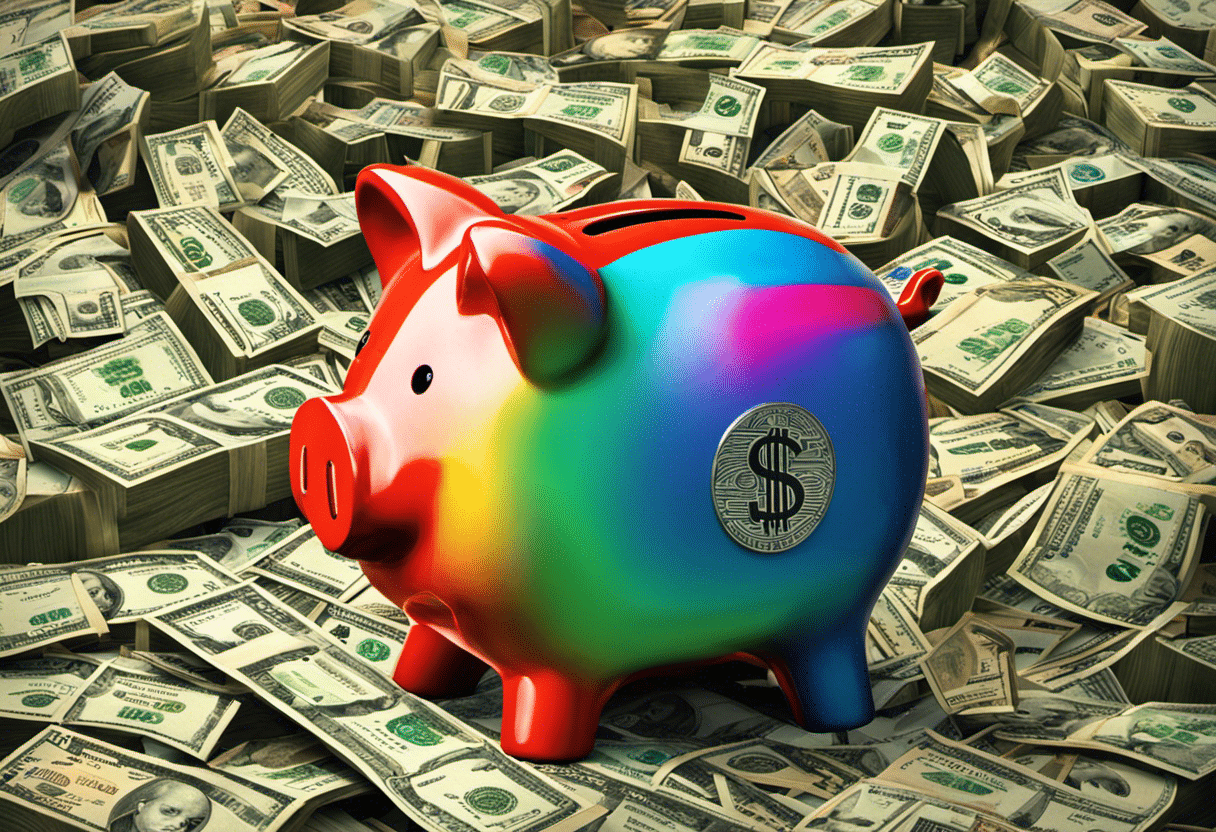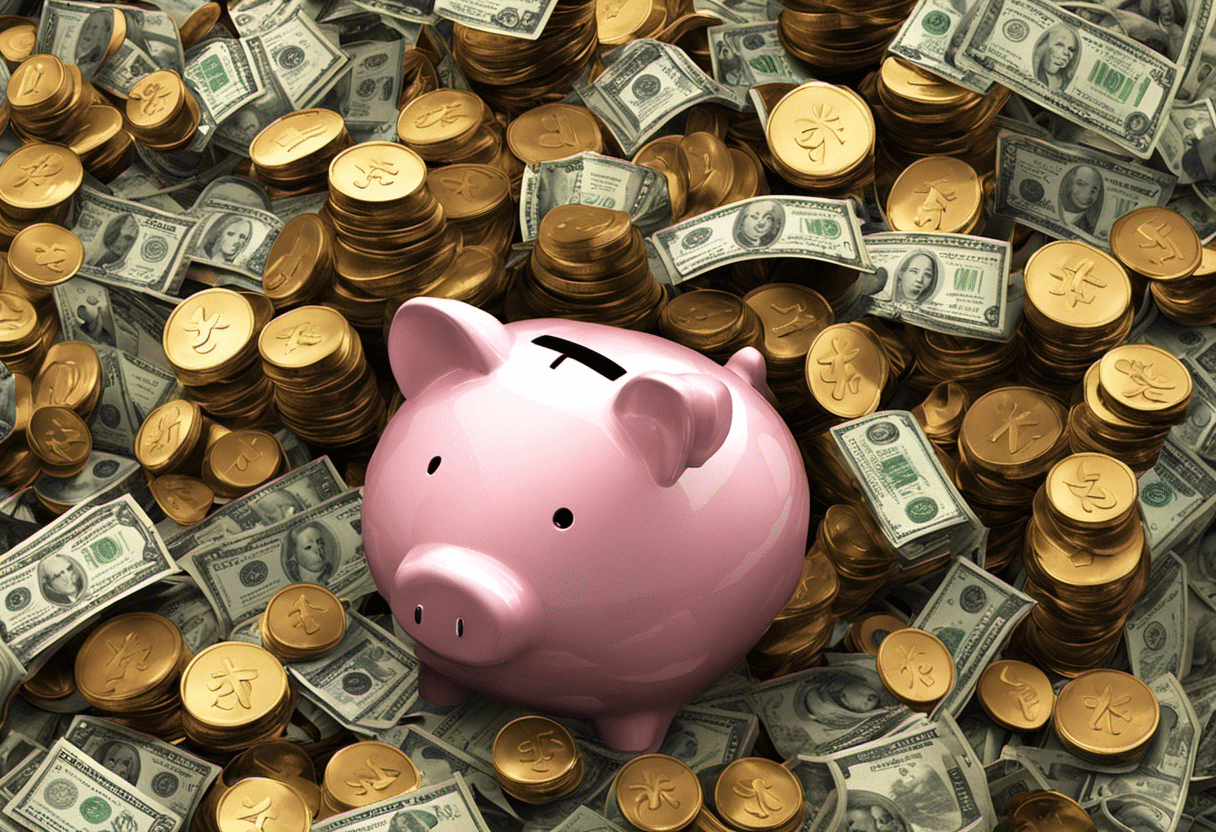Do you dream of owning a home? They say ‘home is where the heart is,’ but saving for a down payment can sometimes feel like an uphill battle. Fear not, for this article will guide you on your journey to homeownership.
We’ll explore the importance of setting a down payment goal, analyze your financial situation, and delve into strategies for saving.
So buckle up and get ready to turn that dream into reality!
Key Takeaways
- Setting a down payment goal provides focus and motivation.
- Analyzing your financial situation helps determine a realistic savings target.
- The ideal down payment percentage depends on personal circumstances.
- Consider all factors, such as income, job stability, and interest rates, to determine the affordability of a desired home.
The Importance of Setting a Down Payment Goal

Setting a down payment goal is crucial when saving for a house. It’s like having a compass to guide you through the choppy waters of homeownership. Without a clear goal in mind, it’s easy to get lost or lose motivation along the way. So, grab your captain’s hat and let’s set sail towards your dream home!
Think of your down payment goal as the treasure chest at the end of the rainbow. It’s what will unlock the door to your new place and make all those Pinterest-worthy decor ideas come true. But how much should you save? Well, that depends on various factors such as the price range of homes you’re considering, your income, and any financial assistance you may qualify for.
By setting a specific down payment goal, you’ll have something tangible to work towards. It gives you focus and helps prioritize saving over other expenses that might tempt you along the way (looking at you, spontaneous weekend getaways!). Plus, having a clear target in mind can motivate you to find creative ways to save more and reach your goal faster.
Now that we’ve charted our course towards setting a down payment goal, let’s navigate into analyzing your financial situation: how much can you afford to save? This step will help ensure smooth sailing on our journey toward homeownership!
Analyzing Your Financial Situation: How Much Can You Afford to Save?

Assessing your financial situation and determining what you can afford to set aside is crucial when planning for a down payment. It’s time to put on your financial detective hat and start digging into those numbers! Here are three key steps to help you analyze your financial situation:
- Calculate your monthly income: Start by adding up all the money that flows into your bank account each month, including your salary, side hustle earnings, and any other sources of income. This will give you a clear picture of how much money you have available to save.
- Track your expenses: Grab a cup of coffee and sit down with your bank statements, credit card bills, and receipts from the past few months. Categorize your expenses into different buckets like housing, transportation, groceries, entertainment, and so on. This will give you an idea of where your money is going and identify areas where you can cut back.
- Set a savings target: Once you have a good understanding of how much money is coming in and going out each month, it’s time to determine how much you can realistically save towards your down payment goal. Consider factors like existing debts or future expenses that may impact your ability to save.
Now that you’ve assessed what you can afford to save, let’s move on to determining the ideal down payment percentage…
Determining the Ideal Down Payment Percentage

Once you have a clear understanding of your financial situation, it’s time to figure out the percentage that would be ideal for your down payment. Determining this percentage can help you set realistic goals and ensure that you are financially prepared for purchasing your dream home.
To make things more interesting, let’s break it down with a handy table:
| Down Payment Percentage | Amount Saved |
|---|---|
| 10% | $30,000 |
| 20% | $60,000 |
| 30% | $90,000 |
Now, keep in mind that these percentages are just general guidelines. The actual amount you need to save will depend on factors such as the price of the house and any additional fees or expenses associated with the purchase.
While a 20% down payment is often recommended to avoid paying private mortgage insurance (PMI), it may not be feasible for everyone. Don’t worry if you can’t reach that number right away – every little bit counts! Start saving whatever amount is comfortable for you and gradually work towards your goal.
So now that you know how much to save for your down payment, let’s dive into considering the real estate market: how much should you save for your desired home?
Considering the Real Estate Market: How Much Should You Save for Your Desired Home?

So, you’re ready to dive into the real estate market and find your dream home. But before you start envisioning those cozy nights by the fireplace, it’s important to consider a few key factors that will determine just how affordable that dream home really is.
In this discussion, we’ll explore the ins and outs of real estate affordability, weighing the pros and cons of saving up versus borrowing to make sure you’re making the right financial decision for your future.
Real Estate Affordability Factors
When thinking about buying a home, you should consider various factors that affect real estate affordability. It’s not just about finding the perfect neighborhood or the right number of bedrooms. There are other important elements to take into account.
First, think about your income and job stability. Lenders want to see that you can comfortably afford your mortgage payments.
Secondly, don’t forget about property taxes and homeowners insurance – they can add up quickly!
Another factor to consider is the condition of the home you’re interested in. Older homes may require more maintenance and repair costs over time.
Finally, keep an eye on interest rates – they can greatly impact how much house you can afford.
Now that you understand the various factors affecting real estate affordability, let’s dive into a discussion on saving versus borrowing for your down payment goals…
Saving Vs. Borrowing
Let’s compare the benefits of saving versus borrowing for your down payment.
Ah, the age-old question: should you squirrel away every penny or lean on Mr. Bank for some extra help?
Saving has its perks – like that satisfying feeling when you finally reach your goal and can proudly say, ‘I did it!’ Plus, you won’t have to worry about those pesky interest payments.
But let’s not dismiss borrowing just yet! With a loan, you can jump into homeownership sooner rather than later. And hey, who doesn’t want to start building equity ASAP?
Now that we’ve weighed the pros and cons of both options, let’s explore down payment assistance programs and grants. Because sometimes a little boost is all you need to make your dreams come true!
Exploring Down Payment Assistance Programs and Grants

So, you’ve been dreaming about buying your own home but the thought of saving up for a down payment seems daunting. Well, fear not! In this next discussion, we’ll dive into the world of Down Payment Assistance Programs and Grants.
We’ll explore who is eligible for these programs, how to navigate through the application process, and what it takes to get approved.
Get ready to turn your dream into a reality with a little help from these fantastic resources!
Eligibility for Assistance
To determine your eligibility for assistance, you should check the specific requirements set by the program.
But hey, don’t worry! It’s not as scary as it sounds. These programs are here to help you achieve your dream of owning a home. They understand that saving up for a down payment can be tough, especially with all those avocado toast cravings. So, they’ve come up with some criteria to make sure the right people get the support they need.
Typically, these requirements include things like income limits, credit score thresholds, and maybe even a pinch of magic (just kidding!). So go ahead and take a peek at what these programs are looking for – who knows? You just might qualify for some sweet assistance!
And speaking of which… let’s dive into the application and approval process next!
Application and Approval Process
Alright, you’ve made it through the eligibility requirements and now it’s time to dive into the application and approval process for down payment assistance. This is where things start to get exciting!
But before we jump in, let me break it down for you in a way that makes sense. Here are a few important things to keep in mind:
- Gather your documents: You’ll need proof of income, tax returns, bank statements, and other financial information.
- Fill out the application: Don’t worry, it’s not as daunting as it sounds. Just take your time and be thorough.
- Wait for approval: This part requires some patience. The program administrators will review your application and make a decision.
- Celebrate (hopefully): If all goes well, you’ll receive an approval letter and can move forward with your down payment assistance.
With the application process under control, let’s move on to some strategies for saving – tips and tricks to reach your down payment goal. Trust me, they’re worth checking out!
Strategies for Saving: Tips and Tricks to Reach Your Down Payment Goal

If you’re looking for strategies to reach your down payment goal, there are many tips and tricks that can help. Saving for a down payment can seem like a daunting task, but with a little creativity and determination, you’ll be able to make it happen.
One strategy is to set up automatic transfers from your checking account into a separate savings account specifically for your down payment. By doing this, you won’t even miss the money as it gets whisked away before you have a chance to spend it on that fancy coffee or impulse purchase.
Another tip is to cut back on unnecessary expenses. Do you really need that monthly subscription box of socks? Probably not.
A fun trick is the ‘spare change challenge.’ Every time you use cash for a purchase, put the spare change into a jar. You’ll be surprised at how quickly those coins add up! And don’t forget about extra sources of income. Consider taking on freelance gigs or selling items you no longer need online.
By implementing these strategies and getting creative with your saving methods, you’ll be well on your way to reaching your down payment goal in no time.
Now let’s talk about balancing saving for a down payment with other financial goals…
Balancing Saving for a Down Payment With Other Financial Goals

When saving for a down payment, it’s important to consider how it fits into your overall financial plan. You might be tempted to throw all your money at that shiny new home, but hold on just a minute! While buying a house is exciting, don’t forget about your other financial goals.
It’s like deciding to eat cake for dinner every night without thinking about the consequences. Sure, owning a home is great, but what about retirement? Or that dream vacation you’ve been longing for? It’s all about finding the right balance.
Take a step back and assess your financial priorities. Maybe you need to allocate some funds towards building an emergency fund or paying off high-interest debt. Remember, life happens and plans change. Reassessing your down payment goal is essential along the way.
Ask yourself: Has your income increased? Have housing prices in your area skyrocketed? Are you expecting any major life changes? Adjusting your down payment goal doesn’t mean giving up on homeownership; it simply means adapting to new circumstances and ensuring that you’re making the best possible choices for your future self.
So go ahead, reassess those goals and make sure they align with where you are now in life.
Reassessing Your Down Payment Goal: When and Why Should You Adjust?

Take a moment to evaluate if you need to make any adjustments to your target for the amount you want to set aside. It’s important to regularly reassess your down payment goal as circumstances and priorities change. Here are three reasons why you might consider adjusting your target:
- Changing financial situation: Life is full of surprises, both good and bad. If your income has increased or decreased significantly since setting your initial goal, it may be time to reevaluate how much you can realistically save each month.
- Housing market fluctuations: The real estate market is constantly evolving, with prices going up and down. If housing prices in your desired area have skyrocketed, it might be necessary to adjust your down payment goal in order to afford a home in that location.
- Reevaluating priorities: As time goes on, you may find that other financial goals become more important than saving for a down payment. Whether it’s starting a family, pursuing further education, or taking that dream vacation, it’s okay to shift your focus and adjust your savings accordingly.
Frequently Asked Questions
What Is the Average Down Payment Percentage for First-Time Homebuyers?
So, you’re wondering about the average down payment percentage for first-time homebuyers? Well, it varies, but generally it’s around 6-10% of the purchase price. Keep saving and you’ll get there!
Are There Any Down Payment Assistance Programs Available for Low-Income Individuals?
Sure, there are down payment assistance programs for low-income folks like you. They can help make buying a home more affordable. Let’s find out how much you need to save first!
How Does the Real Estate Market Affect the Amount I Should Save for a Down Payment?
The real estate market can have a big impact on how much you should save for a down payment. Prices may fluctuate, so it’s important to stay informed and adjust your savings goals accordingly.
Can I Use Funds From My Retirement Account Towards a Down Payment?
Yes, you can use funds from your retirement account towards a down payment. However, it’s important to consider the potential long-term impact on your savings and future financial security.
What Are Some Common Mistakes to Avoid When Saving for a Down Payment?
When saving for a down payment, it’s important to avoid some common mistakes. Don’t underestimate your goal, neglect budgeting, or forget about extra costs. Stay focused and motivated to reach your target!
Conclusion
Congratulations on reaching the end of this article! Now, I know what you might be thinking: ‘Saving for a down payment seems like such a daunting task. Can I really do it?’
Well, let me tell you something – you absolutely can! Sure, it may take some time and effort, but think about the joy and pride you’ll feel when you finally step into your dream home. So don’t let doubts hold you back.
Get started on your saving journey today and make that down payment goal a reality!

